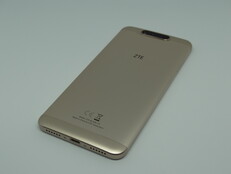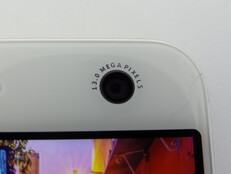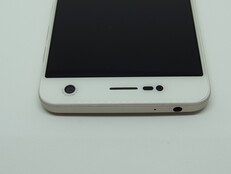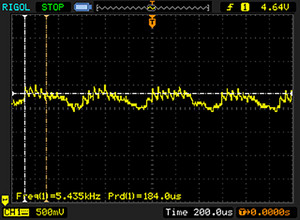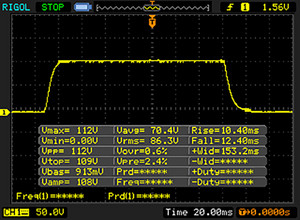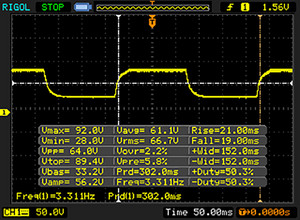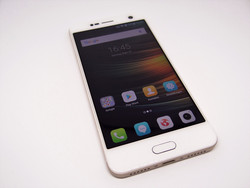Breve Análise do Smartphone ZTE Blade V8
Os Top 10
» Os Top 10 Portáteis Multimídia
» Os Top 10 Portáteis de Jogos
» Os Top 10 Portáteis Leves para Jogos
» Os Top 10 Portáteis Acessíveis de Escritório/Empresariais
» Os Top 10 Portáteis Premium de Escritório/Empresariais
» Os Top 10 dos Portáteis Workstation
» Os Top 10 Subportáteis
» Os Top 10 Ultrabooks
» Os Top 10 Conversíveis
» Os Top 10 Tablets
» Os Top 10 Smartphones
» A melhores Telas de Portáteis Analisadas Pela Notebookcheck
» Top 10 dos portáteis abaixo dos 500 Euros da Notebookcheck
» Top 10 dos Portáteis abaixo dos 300 Euros
Size Comparison
| Networking | |
| iperf3 transmit AX12 | |
| Honor 6X | |
| ZTE Axon 7 Mini | |
| ZTE Blade V8 | |
| iperf3 receive AX12 | |
| Honor 6X | |
| ZTE Blade V8 | |
| ZTE Axon 7 Mini | |
| |||||||||||||||||||||||||
iluminação: 79 %
iluminação com acumulador: 482 cd/m²
Contraste: 753:1 (Preto: 0.64 cd/m²)
ΔE ColorChecker Calman: 4 | ∀{0.5-29.43 Ø4.78}
ΔE Greyscale Calman: 3.4 | ∀{0.09-98 Ø5}
Gamma: 2.13
CCT: 6774 K
| ZTE Blade V8 IPS, 1920x1080, 5.2" | Huawei P9 Lite IPS, 1920x1080, 5.2" | Honor 6X IPS, 1920x1080, 5.5" | ZTE Axon 7 Mini AMOLED, 1920x1080, 5.2" | ZTE Blade V7 IPS, 1920x1080, 5.2" | |
|---|---|---|---|---|---|
| Screen | -5% | -7% | -47% | -58% | |
| Brightness middle (cd/m²) | 482 | 505 5% | 547 13% | 327 -32% | 409 -15% |
| Brightness (cd/m²) | 448 | 468 4% | 540 21% | 335 -25% | 411 -8% |
| Brightness Distribution (%) | 79 | 88 11% | 94 19% | 94 19% | 96 22% |
| Black Level * (cd/m²) | 0.64 | 0.74 -16% | 0.57 11% | 0.38 41% | |
| Contrast (:1) | 753 | 682 -9% | 960 27% | 1076 43% | |
| Colorchecker dE 2000 * | 4 | 4.1 -3% | 5.1 -28% | 6.3 -58% | 9.4 -135% |
| Colorchecker dE 2000 max. * | 6.5 | 5.8 11% | 9.1 -40% | 11.4 -75% | 17.6 -171% |
| Greyscale dE 2000 * | 3.4 | 4.9 -44% | 6.2 -82% | 7.1 -109% | 11.6 -241% |
| Gamma | 2.13 103% | 2.5 88% | 2.09 105% | 2.25 98% | 2.25 98% |
| CCT | 6774 96% | 7116 91% | 6546 99% | 7637 85% | 9597 68% |
* ... menor é melhor
Cintilação da tela / PWM (modulação por largura de pulso)
| Tela tremeluzindo/PWM detectado | 5435 Hz | ≤ 1 % configuração de brilho | |
A luz de fundo da tela pisca em 5435 Hz (pior caso, por exemplo, utilizando PWM) Cintilação detectada em uma configuração de brilho de 1 % e abaixo. Não deve haver cintilação ou PWM acima desta configuração de brilho. A frequência de 5435 Hz é bastante alta, então a maioria dos usuários sensíveis ao PWM não deve notar nenhuma oscilação. [pwm_comparison] Em comparação: 53 % de todos os dispositivos testados não usam PWM para escurecer a tela. Se PWM foi detectado, uma média de 8111 (mínimo: 5 - máximo: 343500) Hz foi medida. | |||
Exibir tempos de resposta
| ↔ Tempo de resposta preto para branco | ||
|---|---|---|
| 22.8 ms ... ascensão ↗ e queda ↘ combinadas | ↗ 10.4 ms ascensão | |
| ↘ 12.4 ms queda | ||
| A tela mostra boas taxas de resposta em nossos testes, mas pode ser muito lenta para jogadores competitivos. Em comparação, todos os dispositivos testados variam de 0.1 (mínimo) a 240 (máximo) ms. » 50 % de todos os dispositivos são melhores. Isso significa que o tempo de resposta medido é pior que a média de todos os dispositivos testados (20.2 ms). | ||
| ↔ Tempo de resposta 50% cinza a 80% cinza | ||
| 40 ms ... ascensão ↗ e queda ↘ combinadas | ↗ 21 ms ascensão | |
| ↘ 19 ms queda | ||
| A tela mostra taxas de resposta lentas em nossos testes e será insatisfatória para os jogadores. Em comparação, todos os dispositivos testados variam de 0.165 (mínimo) a 636 (máximo) ms. » 60 % de todos os dispositivos são melhores. Isso significa que o tempo de resposta medido é pior que a média de todos os dispositivos testados (31.6 ms). | ||
| AnTuTu v6 - Total Score (classificar por valor) | |
| ZTE Blade V8 | |
| Huawei P9 Lite | |
| Honor 6X | |
| ZTE Axon 7 Mini | |
| ZTE Blade V7 | |
| Wiko U Feel Prime | |
| Geekbench 4.0 | |
| 64 Bit Single-Core Score (classificar por valor) | |
| ZTE Blade V8 | |
| Honor 6X | |
| ZTE Axon 7 Mini | |
| Wiko U Feel Prime | |
| 64 Bit Multi-Core Score (classificar por valor) | |
| ZTE Blade V8 | |
| Honor 6X | |
| ZTE Axon 7 Mini | |
| Wiko U Feel Prime | |
| GFXBench (DX / GLBenchmark) 2.7 | |
| T-Rex Onscreen (classificar por valor) | |
| ZTE Blade V8 | |
| Huawei P9 Lite | |
| Honor 6X | |
| ZTE Axon 7 Mini | |
| ZTE Blade V7 | |
| Wiko U Feel Prime | |
| 1920x1080 T-Rex Offscreen (classificar por valor) | |
| ZTE Blade V8 | |
| Huawei P9 Lite | |
| Honor 6X | |
| ZTE Axon 7 Mini | |
| ZTE Blade V7 | |
| Wiko U Feel Prime | |
| GFXBench 3.0 | |
| on screen Manhattan Onscreen OGL (classificar por valor) | |
| ZTE Blade V8 | |
| Huawei P9 Lite | |
| Honor 6X | |
| ZTE Axon 7 Mini | |
| ZTE Blade V7 | |
| Wiko U Feel Prime | |
| 1920x1080 1080p Manhattan Offscreen (classificar por valor) | |
| ZTE Blade V8 | |
| Huawei P9 Lite | |
| Honor 6X | |
| ZTE Axon 7 Mini | |
| ZTE Blade V7 | |
| Wiko U Feel Prime | |
| GFXBench 3.1 | |
| on screen Manhattan ES 3.1 Onscreen (classificar por valor) | |
| ZTE Blade V8 | |
| Huawei P9 Lite | |
| Honor 6X | |
| ZTE Axon 7 Mini | |
| ZTE Blade V7 | |
| Wiko U Feel Prime | |
| 1920x1080 Manhattan ES 3.1 Offscreen (classificar por valor) | |
| ZTE Blade V8 | |
| Huawei P9 Lite | |
| Honor 6X | |
| ZTE Axon 7 Mini | |
| ZTE Blade V7 | |
| Wiko U Feel Prime | |
| PCMark for Android - Work performance score (classificar por valor) | |
| ZTE Blade V8 | |
| Huawei P9 Lite | |
| Honor 6X | |
| ZTE Axon 7 Mini | |
| ZTE Blade V7 | |
| Wiko U Feel Prime | |
| JetStream 1.1 - Total Score | |
| Huawei P9 Lite | |
| Honor 6X | |
| ZTE Axon 7 Mini | |
| Wiko U Feel Prime | |
| ZTE Blade V7 | |
| ZTE Blade V8 | |
| Mozilla Kraken 1.1 - Total | |
| ZTE Blade V7 | |
| ZTE Blade V8 | |
| ZTE Axon 7 Mini | |
| Wiko U Feel Prime | |
| Huawei P9 Lite | |
| Honor 6X | |
| Octane V2 - Total Score | |
| Huawei P9 Lite | |
| Honor 6X | |
| Wiko U Feel Prime | |
| ZTE Axon 7 Mini | |
| ZTE Blade V8 | |
| ZTE Blade V7 | |
| WebXPRT 2015 - Overall | |
| Honor 6X | |
| Huawei P9 Lite | |
| ZTE Axon 7 Mini | |
| ZTE Blade V8 | |
* ... menor é melhor
| ZTE Blade V8 | Huawei P9 Lite | Honor 6X | ZTE Axon 7 Mini | ZTE Blade V7 | Wiko U Feel Prime | |
|---|---|---|---|---|---|---|
| AndroBench 3-5 | -22% | 24% | -23% | -47% | -5% | |
| Sequential Read 256KB (MB/s) | 278.1 | 283.5 2% | 283.4 2% | 230.8 -17% | 196.8 -29% | 270.9 -3% |
| Sequential Write 256KB (MB/s) | 77.7 | 46.24 -40% | 73.8 -5% | 122.8 58% | 39.45 -49% | 137.3 77% |
| Random Read 4KB (MB/s) | 39.89 | 38.22 -4% | 39.55 -1% | 14.05 -65% | 28.07 -30% | 55 38% |
| Random Write 4KB (MB/s) | 12.69 | 15.35 21% | 45.05 255% | 6.7 -47% | 7.58 -40% | 9.4 -26% |
| Sequential Read 256KB SDCard (MB/s) | 96.5 | 60.8 -37% | 52 -46% | 73.9 -23% | 43.67 -55% | 41.98 -56% |
| Sequential Write 256KB SDCard (MB/s) | 87.1 | 25.1 -71% | 34.53 -60% | 50.3 -42% | 20.89 -76% | 35.21 -60% |
| Asphalt 8: Airborne | |||
| Configurações | Valor | ||
| high | 19 fps | ||
| Dead Trigger 2 | |||
| Configurações | Valor | ||
| high | 30 fps | ||
(+) A temperatura máxima no lado superior é 36.5 °C / 98 F, em comparação com a média de 35.2 °C / 95 F , variando de 21.9 a 247 °C para a classe Smartphone.
(+) A parte inferior aquece até um máximo de 33.3 °C / 92 F, em comparação com a média de 34 °C / 93 F
(+) Em uso inativo, a temperatura média para o lado superior é 31.5 °C / 89 F, em comparação com a média do dispositivo de 32.9 °C / ### class_avg_f### F.
ZTE Blade V8 análise de áudio
(±) | o volume do alto-falante é médio, mas bom (###valor### dB)
Graves 100 - 315Hz
(-) | quase nenhum baixo - em média 26.9% menor que a mediana
(±) | a linearidade dos graves é média (9% delta para a frequência anterior)
Médios 400 - 2.000 Hz
(±) | médios mais altos - em média 6.5% maior que a mediana
(±) | a linearidade dos médios é média (8.7% delta para frequência anterior)
Altos 2 - 16 kHz
(±) | máximos mais altos - em média 8.5% maior que a mediana
(±) | a linearidade dos máximos é média (8.7% delta para frequência anterior)
Geral 100 - 16.000 Hz
(-) | o som geral não é linear (31.7% diferença em relação à mediana)
Comparado com a mesma classe
» 81% de todos os dispositivos testados nesta classe foram melhores, 2% semelhantes, 16% piores
» O melhor teve um delta de 11%, a média foi 35%, o pior foi 134%
Comparado com todos os dispositivos testados
» 90% de todos os dispositivos testados foram melhores, 2% semelhantes, 8% piores
» O melhor teve um delta de 4%, a média foi 24%, o pior foi 134%
Huawei P9 Lite análise de áudio
(+) | os alto-falantes podem tocar relativamente alto (###valor### dB)
Graves 100 - 315Hz
(-) | quase nenhum baixo - em média 31% menor que a mediana
(±) | a linearidade dos graves é média (9.2% delta para a frequência anterior)
Médios 400 - 2.000 Hz
(+) | médios equilibrados - apenas 4.4% longe da mediana
(+) | médios são lineares (4.2% delta para frequência anterior)
Altos 2 - 16 kHz
(±) | máximos mais altos - em média 5.2% maior que a mediana
(+) | os máximos são lineares (2.2% delta da frequência anterior)
Geral 100 - 16.000 Hz
(±) | a linearidade do som geral é média (21% diferença em relação à mediana)
Comparado com a mesma classe
» 38% de todos os dispositivos testados nesta classe foram melhores, 8% semelhantes, 54% piores
» O melhor teve um delta de 11%, a média foi 35%, o pior foi 134%
Comparado com todos os dispositivos testados
» 57% de todos os dispositivos testados foram melhores, 7% semelhantes, 36% piores
» O melhor teve um delta de 4%, a média foi 24%, o pior foi 134%
Honor 6X análise de áudio
(±) | o volume do alto-falante é médio, mas bom (###valor### dB)
Graves 100 - 315Hz
(-) | quase nenhum baixo - em média 21.7% menor que a mediana
(±) | a linearidade dos graves é média (10.2% delta para a frequência anterior)
Médios 400 - 2.000 Hz
(±) | médios mais altos - em média 8.4% maior que a mediana
(±) | a linearidade dos médios é média (7.8% delta para frequência anterior)
Altos 2 - 16 kHz
(±) | máximos mais altos - em média 6.7% maior que a mediana
(+) | os máximos são lineares (5.8% delta da frequência anterior)
Geral 100 - 16.000 Hz
(±) | a linearidade do som geral é média (29.1% diferença em relação à mediana)
Comparado com a mesma classe
» 76% de todos os dispositivos testados nesta classe foram melhores, 3% semelhantes, 21% piores
» O melhor teve um delta de 11%, a média foi 35%, o pior foi 134%
Comparado com todos os dispositivos testados
» 87% de todos os dispositivos testados foram melhores, 2% semelhantes, 11% piores
» O melhor teve um delta de 4%, a média foi 24%, o pior foi 134%
| desligado | |
| Ocioso | |
| Carga |
|
Key:
min: | |
| ZTE Blade V8 2730 mAh | Huawei P9 Lite 3000 mAh | Honor 6X 3340 mAh | ZTE Axon 7 Mini 2705 mAh | ZTE Blade V7 2540 mAh | |
|---|---|---|---|---|---|
| Duração da bateria | 6% | 65% | -16% | -26% | |
| Reader / Idle (h) | 16.1 | 23.4 45% | 37.5 133% | 21.5 34% | |
| H.264 (h) | 9.1 | 9.5 4% | 14.8 63% | 7.3 -20% | |
| WiFi v1.3 (h) | 11.7 | 10.1 -14% | 16 37% | 6.7 -43% | 8.7 -26% |
| Load (h) | 5 | 4.5 -10% | 6.3 26% | 3.3 -34% |
Pro
Contra
No final deste teste, surge a questão sobre para quem é este aparelho. Principalmente para os caçadores de pechinchas que querem um monte de recursos por pouco dinheiro. Esses compradores recebem uma câmera dupla e uma câmera frontal de 13 megapixels. Suporte para áudio Dolby está disponível para os alto falantes. Uma boa duração da bateria, boa tela e expansão de armazenamento via micro-SD também pertence ao pacote.
O Blade V8 é um smartphone que traz bom desempenho para a gama média a um preço baixo.
E o ruim? Os compradores devem estar cientes de que este não é um smartphone premium, apesar da carcaça de alumínio. A configuração atual é bastante média, mas não mais que isso. Deve optar por um modelo mais caro se desejar mais potência e uma melhor configuração. As taxas de desempenho medíocres na comparação do desempenho são realmente o maior ponto de crítica. Infelizmente, os alto-falantes são muito fracos sem Dolby Audio, e isso resulta na falta de volume. A câmera apresenta fraquezas evidentes em situações de baixa iluminação.
ZTE Blade V8
- 03/29/2017 v6 (old)
Niklas Böhm




